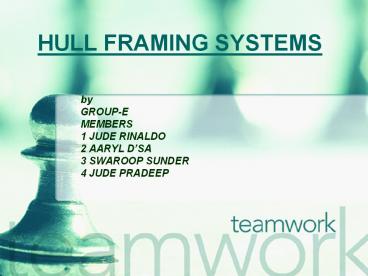HULL FRAMING SYSTEMS PowerPoint PPT Presentation
Title: HULL FRAMING SYSTEMS
1
HULL FRAMING SYSTEMS
- by
- GROUP-E
- MEMBERS
- 1 JUDE RINALDO
- 2 AARYL DSA
- 3 SWAROOP SUNDER
- 4 JUDE PRADEEP
2
- Describe with neat diagrams the longitudinal
framing system and list their advantages and
disadvantages.
3
FRAMING
- The shell(bottom and side)and deck plating of the
ship has to be stiffened internally to prevent it
from collapsing. The stiffening is generally
provided by - Primary supporting members
- Secondary supporting members
- Primary supporting members are the big
members or metaphorically speaking the big bones
such as web frames,girders,solid floors,etc - Secondary supporting members are the small
bones of the ship such as longitudinals,hold
frames,deck beams.
4
Longitudinal framing system
- Longitudinal framing system is included in
secondary supporting members - Longitudinal framing system is used for larger
ships where longitudinal strength is a major
consideration - They are much smaller in size as compared to
primary supporting members
5
Longitudinal framing system
6
Longitudinal Structural Components
- Starting from the keel to the deck
- Keel
- - Large center-plane girder
- - Runs longitudinally along the bottom of
the ship - Longitudinals
- - Girders running parallel to the keel
along the bottom - - It provides longitudinal strength
7
Longitudinal Structural Components
- Stringer
- Girders running along the sides of the ship
- Typically smaller than a longitudinal
- Provides longitudinal strength
- Deck Girder
- Longitudinal member of the deck frame (deck
longitudinal)
.Primary role of longitudinal members Resist
the longitudinal bending stress due to sagging
and hogging
8
LONGITUDINAL MEMBERS
TRANSVERSE MEMBERS
DECK PLATING
DECK BEAM
DECK GIRDERS
STRINGERS
FRAME
PLATING
LONGITUDINAL
KEEL
FLOOR
9
Longitudinal framing system
- In this system,all the secondary supporting
members are fitted in the longitudinal direction
and are known as longitudinals. - Some of them are
- Bottom longitudinals
- Side longitudinals
- Deck longitudinals
- The system consist of many
small,closely spaced longitudinals supporting the
plating directly and being supported in turn by a
few large ,widely spaced longitudinals
10
Longitudinal framing system
- The bottom longitudinal on centreline,or centre
girder, is extra large and heavy,principally to
carry the loads imposed by keel blocks during dry
docking - Very deep, heavy transverse structures called
transverse webs or web frames are constructed at
intervals of about 3 to 5 metres to support the
longitudinals - Where a ships length exceeds 120 m it is
considered desirable to adopt longitudinal
framing - Tankers greater than 200 m in length must be
framed longitudinally
11
Longitudinal framing system
12
Longitudinal framing system
13
Longitudinal framing system in Tankers
- When a ship exceeds 120 m it is considered
desirable to adopt longitudinal framing - This is the main system used in tankers greater
than about 200m in length where longitudinal
strength is a major consideration - Adoption of any other system will result in
unacceptably large hull weight - Longitudinal stiffeners spaced about 600 to 900
mm apart give direct support to the plating of
the decks,sides,bottom and bulkheads - They also contribute to the longitudinal strength
of the ship,making the longitudinal framing
system more structurally efficient than the
transverse system
14
Longitudinal framing system in Tankers
15
Longitudinal framing system in Tankers
16
Advantages of longitudinal framing system
- The advantages of longitudinal framing system
are as follows - Longitudinally stiffened plating is more
resistant to buckling especially prevalent in
ships upper deck. - When the deck or bottom is subjected to
compressive stresses as it bends in a seaway than
it would be if stiffened transversely. - Longitudinal stiffeners supporting side shell and
bulkhead plating are subjected to variable
pressures from the sea or from liquid cargo. The
hydrostatic pressure on each successive
longitudinal and its associated plating increases
with its depth below the waterline or below the
surface of the liquid in the tank.
17
Advantages of longitudinal framing system
- Each longitudinal can be sized to withstand the
maximum pressure associated with its depth in the
ship, thus achieving an efficient use of
structural material. - Graduated size cannot be done effectively with
transverse frames, which as a result are only
heavy at their upper ends.
18
Disadvantages of longitudinal framing system
- Though the longitudinal framing system has a
lot of advantages,it also has some
disadvantages.They are as follows - The intrusion of deep webs into prime cargo
spaces for ships carrying packaged cargo is an
disadvantage. - Difficulty arises in the structural arrangements
near the ends of the ship. - As the hull narrows towards the bow and
stem,however, the girth necessarily reduces and
the longitudinals becomes closer together - Difficulties in construction arise when they
converge so closely that some longitudinals have
to be eliminated

